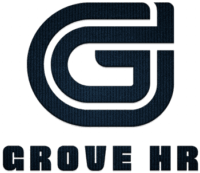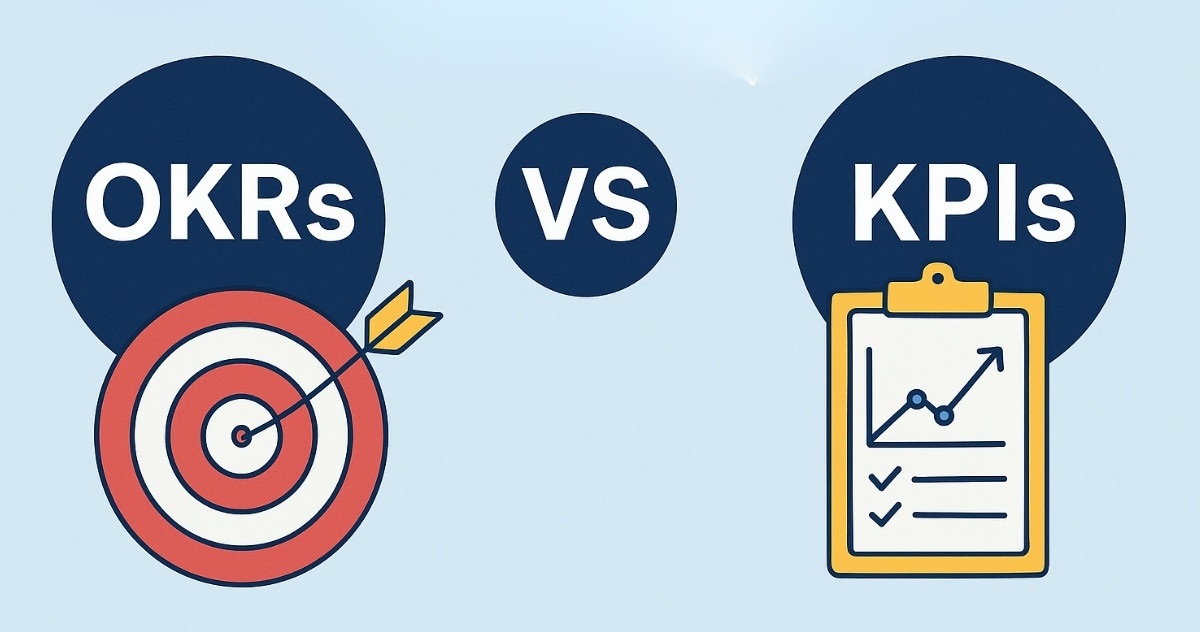Human resources departments face constant pressure to demonstrate value and drive measurable business results.
The debate around OKRs vs KPIs has become central to modern HR strategy discussions. Yet, many HR professionals remain confused about when to use each framework.
OKRs (Objectives and Key Results) and KPIs (Key Performance Indicators) serve different purposes in your HR arsenal. OKRs help set ambitious goals and drive strategic transformation, such as improving diversity hiring by 40% or reducing time-to-hire by half.
KPIs track ongoing performance metrics, such as employee turnover rates, satisfaction scores, and recruitment costs.
You will learn the fundamental difference between OKRs and KPIs, discover practical examples for HR departments, understand when to implement each framework, and see how successful companies combine both approaches.
What Are OKRs and How Do They Work in HR?

OKRs represent a goal-setting methodology that connects ambitious objectives with measurable key results. The OKR structure forces HR teams to think beyond daily operations and focus on transformational outcomes.
Each OKR consists of one qualitative objective paired with 2-4 quantitative key results. For example, an HR objective might be “Transform our workplace culture to attract top talent,” with key results measured by Employee Net Promoter Score, time-to-hire for senior positions, and offer acceptance rates.
HR departments benefit from OKRs because they align people strategies with business objectives. OKRs foster accountability through regular check-ins and progress updates, typically conducted every quarter.
The framework encourages teams to set stretch goals that push them beyond their comfort zones. Unlike traditional goal-setting methods, OKRs expect 70% achievement rates rather than 100%.
KPIs in the HR Context

KPIs measure ongoing performance against established benchmarks and standards. They encompass various criteria, including retention rate, employee morale, and customer satisfaction.
KPIs provide the operational pulse of your HR function through consistent monitoring and reporting.
Common examples include employee turnover rates, time-to-fill positions, training completion percentages, and absenteeism rates. Each metric tells a specific story about your workforce’s performance and helps identify areas that need attention.
The power of KPIs lies in their ability to spot trends and patterns over time. Monthly turnover tracking might reveal seasonal patterns, departmental issues, or the impact of policy changes.
KPIs are most effective when they directly relate to business outcomes and remain actionable. Measuring “employee happiness” sounds good, but provides little actionable insight.
Measuring “employee satisfaction scores by department with monthly trends” gives HR leaders specific data to drive improvements.
The Fundamental Difference Between OKRs and KPIs
The main benefit is that OKRs provide the ‘what’ and the ‘why’, while KPIs give the ‘how’. OKRs focus on future aspirations and breakthrough achievements, while KPIs monitor current state performance and operational health.
OKRs drive strategic change through ambitious goal-setting and regular progress reviews. They answer questions like “What transformational impact do we want to achieve?” and “How will we measure breakthrough success?”
KPIs answer operational questions such as “How efficiently are we recruiting?” and “What is our current employee satisfaction level?”
Time horizons differ significantly between the frameworks. OKRs typically span quarterly or annual periods, focusing on significant improvements and innovations. KPIs provide ongoing measurement through daily, weekly, or monthly tracking of stable metrics.
The measurement philosophy also differs substantially. OKRs incorporate stretch goals, where a 70% achievement rate indicates an appropriate level of ambition.
KPIs aim for consistent performance against established benchmarks where 100% achievement or better represents success. Each framework requires a different mindset and management approach.
When to Choose OKRs

OKRs excel when your HR department needs to drive significant change or tackle complex challenges.
Use OKRs when launching major initiatives such as digital transformation projects, culture change programs, or diversity and inclusion improvements.
Start with OKRs during periods of organizational growth, merger integration, or strategic pivots. For example, a company expanding internationally might use OKRs to build global talent acquisition capabilities or develop remote work policies.
The ambitious nature of OKRs helps push teams beyond incremental improvements toward breakthrough results.
Start by identifying your biggest strategic priorities. Ask yourself what would make the most important positive impact on your organization over the next quarter or year.
Transform each major challenge into an inspiring objective, then define 2–4 measurable key results that would indicate success.
Implementation requires consistent communication and regular progress reviews to ensure effective execution. Schedule monthly or bi-weekly OKR check-ins to assess progress, remove obstacles, and adjust tactics.
Create transparency by sharing OKRs across the organization and celebrating both successes and learning opportunities from stretch goals.
When KPIs Make More Sense for HR Teams
KPIs are most effective for measuring HR performance in stable, ongoing operations. Choose KPIs when you need to track routine processes, monitor service levels, or maintain consistent quality standards. Examples include recruitment pipeline health, employee onboarding completion rates, and payroll accuracy metrics.
Use KPIs to establish baselines and track incremental improvements over time. If your recruiting process typically takes 45 days to fill positions, a KPI helps monitor progress toward reducing that timeframe to 30 days.
Strategic HR metrics, measured through KPIs, help demonstrate the value of HR to business leaders. Executives appreciate consistent reporting on turnover costs, time-to-productivity for new hires, and training ROI calculations. Regular KPI reporting builds credibility and supports budget requests for HR initiatives.
Automated reporting saves time while ensuring consistent measurement across all HR functions. Focus on KPIs that directly connect to business outcomes and provide actionable insights for continuous improvement.
Real-World HR KPIs Examples for 2025
Modern HR departments track a diverse range of metrics to measure workforce effectiveness and employee experience. Essential HR KPIs examples include employee turnover rate, time-to-hire, cost-per-hire, employee satisfaction scores, and training completion rates. Each metric offers distinct insights into various aspects of human capital management.
Recruitment KPIs measure hiring effectiveness through metrics such as source-of-hire quality, offer acceptance rates, and new hire retention at 90 days. For example, tracking which recruitment sources produce employees who stay longer helps refine hiring strategies.
Employee engagement KPIs include pulse survey scores, internal mobility rates, and voluntary turnover by department. Advanced organizations track employee Net Promoter Scores and measure manager effectiveness through team engagement levels. Regular measurement helps identify engagement trends before they become retention problems.
View this post on Instagram
| HR KPI Category | Key Metrics | Measurement Frequency |
| Recruitment | Time-to-hire, Cost-per-hire, Quality of hire | Monthly |
| Retention | Turnover rate, Exit interview insights | Monthly |
| Performance | Goal achievement, Training completion | Quarterly |
| Engagement | Satisfaction scores, Internal mobility | Quarterly |
Development and performance KPIs track the effectiveness of learning programs, skill gap closure rates, and career progression metrics. Measuring training ROI through performance improvements and retention rates helps justify learning investments.
OKRs for Human Resources: Practical Examples
Effective OKRs for human resources focus on transformational outcomes rather than incremental improvements.
A talent acquisition OKR might state, “Build world-class technical recruiting capabilities,” with key results measuring time-to-hire reduction, candidate experience scores, and improvements in diversity hiring.
Employee experience OKRs could target “Create an exceptional employee experience that drives retention” with key results tracking onboarding satisfaction, manager effectiveness scores, and voluntary turnover reduction.
Culture transformation OKRs work well for organizations undergoing significant change.
An objective such as “Establish a high-performance culture” might include key results that measure increases in employee engagement, internal promotion rates, and the effectiveness of performance management.
Learning and development OKRs focus on capability building across the organization. Examples include “Develop next-generation leadership pipeline” with key results tracking leadership program completion, succession planning readiness, and high-potential employee retention.
Combining OKRs and KPIs
Although both frameworks can function independently, they work best when used in conjunction. KPIs provide a day-to-day operational performance measure, while OKRs help aim for long-term strategic goals.
Competent HR departments leverage both frameworks to create comprehensive performance management systems.
Use KPIs to establish operational baselines and monitor ongoing HR service delivery. Simultaneously, deploy OKRs to drive breakthrough improvements and strategic initiatives.
For example, maintain KPIs for current recruiting metrics while using OKRs to transform your employer brand and candidate experience.
HR strategy and goal alignment improve when both frameworks support each other. KPIs might reveal that employee satisfaction scores have plateaued at 7.2 out of 10.
An OKR could target breakthrough improvement to 8.5+ through specific culture and management initiatives.
The integration requires careful planning to avoid metric overload. Focus on 5–7 core KPIs for operational monitoring and 3–5 OKRs for strategic transformation.
Regular reviews should examine both operational health through KPIs and strategic progress through OKRs, creating comprehensive performance visibility.
Implementation Best Practices and Common Pitfalls
Successful implementation begins with a clear definition of purpose for each framework—specifically, which metrics are for operations and which aim for strategic impact.
Avoid the common mistake of treating OKRs like traditional goals with 100% achievement expectations.
Training managers and team members on each framework prevents confusion and misalignment. OKRs require different coaching conversations focused on stretch goals and learning opportunities.
KPI discussions center on operational efficiency and process improvements.
Common pitfalls include creating too many metrics, setting insufficiently ambitious OKRs, or choosing KPIs without clear action plans.
Start small with 3–5 initial metrics in each category, then expand based on success and organizational maturity. Quality matters more than quantity in both frameworks.
Technology selection significantly impacts implementation success. Choose platforms that support both OKR tracking and KPI dashboard creation. Integration with existing HR systems reduces manual work and improves data accuracy.
Regular training on new tools ensures consistent adoption across all team members.
ROI and Impact Assessment
To prove HR’s impact, connect your metrics to real business outcomes. Calculate the financial impact of improved retention rates, faster hiring processes, and enhanced productivity.
Demonstrate how OKR achievements and KPI improvements contribute to bottom-line results.
ROI calculations should include both direct cost savings and productivity improvements. For example, reducing turnover from 15% to 10% saves recruitment costs while improving team productivity and knowledge retention.
Quantify each benefit to build compelling business cases for continued investment.
Success measurement extends beyond financial metrics to include cultural and strategic impacts. Improved employee engagement scores correlate with increased customer satisfaction and innovation.
Document both quantitative and qualitative benefits to show comprehensive HR value creation.
Regular impact assessment through quarterly business reviews helps refine both OKR and KPI strategies.
Share success stories, lessons learned, and upcoming plans with executive leadership to maintain alignment with leadership. Consistent communication fosters support for HR initiatives and builds credibility.
The Evolution of HR Metrics in 2025

HR metrics are shifting toward predictive analytics and AI-driven insights. These tools help anticipate turnover, identify future leaders, and improve workforce planning.
Employee experience measurement is moving beyond annual surveys toward real-time feedback and sentiment tracking.
Modern teams now monitor key moments in the employee journey, using both OKRs and KPIs to adjust strategy at every stage.
Remote and hybrid work models require new ways of measuring performance and engagement.
OKRs encourage collaboration across distributed teams, while KPIs track consistency and well-being. Both frameworks need to evolve with workplace trends.
Privacy and ethical AI standards are becoming central to HR data strategy. Companies must balance effective measurement with employee trust and clear communication. Transparency around data use is no longer optional—it’s essential.
Which Framework Fits Your HR Strategy?
The choice between OKRs and KPIs depends on your team’s current focus. Use KPIs to gain operational clarity; turn to OKRs when targeting bold improvements or cultural change.
OKRs require a shift in mindset and more coaching, while KPIs are easier to adopt for teams used to traditional metrics. Choose based on how ready your team is for change.
Most HR teams benefit from using both. Start with your biggest need, build confidence, and expand gradually. This prevents overload and helps create long-term value.
KPIs vs OKRs for teams ultimately comes down to balancing operational excellence with strategic transformation. Neither framework alone provides complete visibility into performance.
The combination creates robust measurement systems that drive both day-to-day effectiveness and long-term breakthrough results.
Frequently Asked Questions
Can small HR teams effectively use both OKRs and KPIs?
Small HR teams should start with 3–5 core KPIs for operational monitoring, then add 1–2 strategic OKRs once measurement habits develop. Prioritize wisely to avoid metric overload.
What technology tools work best for tracking both frameworks?
HR analytics platforms integrated with your HRIS system work best. Look for tools that support KPI dashboards and structured OKR tracking in one place.
How do you prevent employees from gaming OKRs or KPIs?
Use outcome-based metrics, ensure transparency, and foster a learning culture. Regular reviews and recalibration help maintain trust in the system.
What is the ideal ratio of leading versus lagging indicators in HR KPIs?
Aim for 60% leading indicators (like engagement trends) and 40% lagging indicators (like turnover). This balance enables proactive decision-making.
How do you align HR objectives and key results with business strategy?
Start from company goals, define HR’s contribution, and involve cross-functional teams to ensure alignment.
Conclusion
OKRs and KPIs serve different but equally important roles in HR strategy. Use KPIs to monitor daily operations and ensure consistency. Rely on OKRs to push forward big changes and long-term improvements.
The best-performing HR teams don’t choose one over the other—they use both. Start small, focus on what matters most now, and grow your approach step by step.
By combining both tools, HR can move from support function to strategic driver, creating real impact across the organization.

